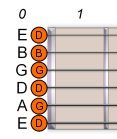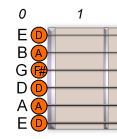 In one of my previous posts I described the basic dropped tunings: drop D, double drop D, and drop C (feel free to check it out if you haven’t already).
In one of my previous posts I described the basic dropped tunings: drop D, double drop D, and drop C (feel free to check it out if you haven’t already).
So today it’s time to talk about some opened tuning.
As I said last time, alternate tunings are ones where at least one string is tuned differently than usual.
Opened tunings are cool for one main reason. Once you strum the strings without fretting any of them down you will hear a complete chord (depending on the opened tuning you’ve chosen).
So for example, after tuning your guitar to the open D you will get a D major chord when you strike all strings. The open C will give you a C major chord, and so on.
Open G guitar tuning
Let’s start with open G for no particular reason. First, the layout of the notes on the open strings:

As you can see, the strings of D, G, and B are already sitting within the G major chord, so only thing we have to do now is take care of the E1, E6, and A5 strings.
Start normally, by tuning your guitar to the standard tuning. Then tune your E6 string down to the nearest D, A5 down to the nearest G, and E1 down to the nearest D. This is the open G guitar tuning.
Open C guitar tuning
The open C tuning produces the C major chord when all strings are struck. The main diagram looks like this:

The story is very similar here. You start by tuning your guitar normally, but then you have to adjust the notes on these four strings:
- The E6 string goes down to the nearest C.
- The A5 string goes down to the nearest G.
- The D4 string goes down to the nearest C.
- The B2 string goes up to the nearest C.
This particular tuning requires a little more work, but it sounds really cool so it’s surely worth checking out.
Open D guitar tuning
The final tuning on this list is the open D guitar tuning. It is believed to be one of the best sounding tunings out there.

As always, start with the standard tuning. Then focus on these fours string to get them in tune:
- The E6 string goes down to the nearest D.
- The G3 string goes down to the nearest F# (that’s a new).
- The B2 string goes down to the nearest A.
- The E1 string goes down to the nearest D.
Whether it truly is the best sounding tuning or not is up to you to decide. Anyway, worth checking out just for this one purpose.
That’s it for the three most basic opened tunings. Tune in next time because we’re going to be discussing yet another portion of alternate guitar tunings. Until then, don’t forget to subscribe to this blog (you’ll get the posts delivered to your email address the minute they are published).






Comments by Carlos
Learning Guitar – What Are the Possibilities
Good point, thanks. I will have to give it a ...
Getting To Know The Top 10 Most Famous Guitars
Apparently, Ultimate-Guitar.com readers didn't consider it being famous enough. You ...
Guitar Lessons: The Next Step Past Basics
I've started my adventure with classical guitar too. Cheers!
Learning the Basics of Guitar Theory
From my experience, the best way is to take a ...
Learn How to Play Guitar by Ear
Thanks for commenting, Olaf :)